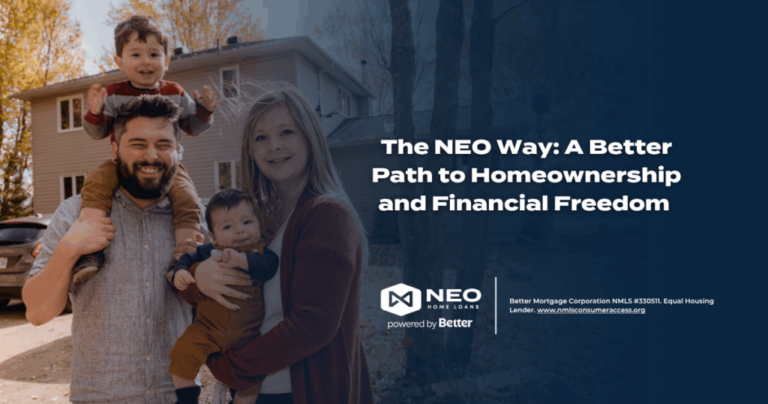
The idea of a 50 year mortgage has taken over social media and the news cycle. Some people think it could finally help more families afford a home. Others think it is a terrible idea that stretches debt too far.
Before we label it good or bad, it is worth slowing down and looking at what this really is.
And to make it completely clear up front:
A 50 year mortgage does not exist today. It is not a loan you can apply for. It is simply an idea being discussed.
Once you understand that, the conversation becomes a lot easier to explore.
Why People Are Even Talking About This
Home affordability has become a real struggle. Prices keep climbing. Rates have not fallen the way many hoped. And the average age of today’s first time homebuyer is now around 40.
People are frustrated, and they are looking for options that can help.
Greg Allen, NEO Mortgage Advisor in Dayton Ohio, sees this firsthand every day. He said, “A lot of people have strong opinions on the idea but they can’t see past the 50 year term. In my opinion it should be used as a tool.”
He also pointed out something most people forget. When the 30 year mortgage was first introduced after the Great Depression, people mocked it. They laughed at the idea of borrowing for that long. But eventually it became the standard because families needed a way to afford housing.
Sometimes new ideas show up because the world looks different than it used to.
The Legal Reality: Why A 50 Year Mortgage Would Be Hard To Implement
To understand whether this idea could ever become real, we need to look at the rules that govern mortgages today.
Jason Russell, NEO Mortgage Advisor in Fairfield California, explains it in a simple way.
After the 2008 financial crisis, new rules were created to protect borrowers. One of those rules says that for a loan to be considered a Qualified Mortgage, it cannot have a term longer than 30 years.
Lenders prefer Qualified Mortgages because they come with legal protections. When a loan falls outside those protections, the lender takes on more risk.
Jason puts it this way:
“Any time a loan falls outside the Qualified Mortgage rules, the lender has to price in the additional risk. We already see this with 40 year loans. They cost more than 30 year loans, not because the lender is being unfair, but because the loan structure itself is riskier.”
So even without quoting any specific rate, the logic is clear.
If a 40 year mortgage costs more than a 30 year, a 50 year mortgage would almost certainly cost even more.
That does not make it bad. It just means people would need to understand the tradeoff.
The Math: Lower Payments Today, Higher Cost Over Time
Even without quoting any rates, the math behind longer term loans is well known.
When you stretch a loan out over more years, the monthly payment drops. This is the part that attracts people. Lower payments make affordability easier in the short term.
But there is another side of the equation.
When you extend a loan, interest accrues over a longer period. That means the total cost of the loan increases. And because you are paying down the balance more slowly, equity builds at a slower pace.
Jason explains it this way:
“If you borrow the same amount over a longer period, your monthly payment is lower, but you end up paying significantly more interest over the life of the loan. It also takes much longer for your principal balance to move in a meaningful way.”
The math is not good or bad. It just is what it is. It helps some people now and costs more later.
Greg Allen’s View: A Tool, Not a Life Sentence
Greg’s perspective is simple and refreshingly honest.
“The question you have to ask yourself is are you Dave Ramsey or Robert Kiyosaki? Dave will tell you to take the 15 year fixed. That is ideal. But if you can’t afford that, Robert would say acquire the asset.”
Greg believes real life rarely fits into a one size fits all box. For some people, a longer term might be the only way to get into a home at all. Once they are in, they can refinance into a shorter term when rates improve.
He also points out that someone who holds property long term may find a lower payment helpful, especially for cash flow.
“I am in the business of acquiring assets. I don’t have to sell. A 50 year mortgage would actually help with cash flow on a rental property. It is a tool, not a long term solution.”
This perspective does not say a 50 year mortgage is good. It also does not say it is bad. It says the value depends on the person using it.
Mike Hajjar’s Balanced Take: It Depends on the Situation
Mike Hajjar, also a NEO Mortgage Advisor in Farmington Hill Michigan, has been reading the reactions online, and he sees both sides loudly represented.
He explained it like this:
“There is very mixed feedback. Half the people say how horrible it is, others talk about how to leverage the difference and invest it for growth. The problem is most people are comparing it to 30 year rates, which probably will not be the case. But if it is, it could be the right fit for certain people.”
His insight captures the heart of this debate.
A 50 year mortgage is not a universal solution. It is a situational tool.
For some people it could help. For others it would not make any sense at all.
The Pros and Cons in Plain English
Potential Benefits
- Lower monthly payments
- Easier qualification for many buyers
- Breathing room during high inflation or economic uncertainty
- More cash flow for long term property owners
- A bridge to refinance later when rates improve
Potential Drawbacks
- Much higher total interest over time
- Very slow equity growth
- Longer time in debt
- Higher pricing compared to standard loans
- Less wealth building if someone stays in the loan too long
Nothing in this list makes the idea automatically good or automatically bad. It all depends on the person, the market, and the plan.
If This Ever Becomes Real, Here’s How NEO Thinks About It
If a 50 year mortgage ever moves from idea to reality, the real question becomes: how do you make a smart decision in a confusing market?
At NEO, our belief is simple. Debt should create clarity, not stress. And the only way to get that clarity is to look at your entire financial picture, not just the payment in front of you.
That is why our Mortgage Advisors lean on systems that turn your loan into a long term strategy rather than a one time transaction.
For example:
• RateWatch was built so clients never have to guess when a refinance makes sense.
• Home Equity Monitoring helps people understand how wealth builds over time instead of hoping their home value grows.
• Mortgage Under Management exists because a mortgage should be managed the same way people manage investments and retirement.
• Transition Planning helps families map out their next move long before life forces one on them.
• And the NEO Experience App keeps all of this organized so clients always know where they stand.
These tools are not here to “sell” anything. They were created because the market is complicated, the world is changing fast, and families deserve more than a guess when they make the biggest financial decisions of their lives.
A 50 year mortgage may or may not ever become real. But the need for clarity, strategy, and long term thinking is not going anywhere.
Final Thought
Headlines come and go, but here is the part that matters:
The smartest mortgage is the one that fits your life, your goals, and your future… not the one getting the most attention online.
And that is the kind of clarity NEO is built to deliver.










